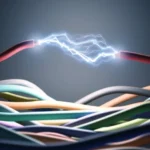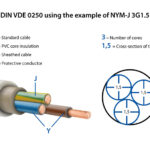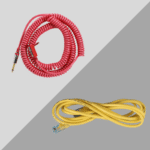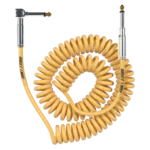 What Is a Fiber Optic Cable?
What Is a Fiber Optic Cable?
A fiber optic cable is a type of data transmission cable that uses light to transmit data. Unlike traditional copper cables (like Ethernet or coaxial cables) that rely on electrical signals, fiber optic cables use pulses of light to transfer data at incredibly fast speeds over long distances. This makes them the preferred choice for high-speed internet connections, telecommunications, and data networking.
Fiber optic technology offers better performance and higher bandwidth than copper cables, making it the backbone of modern communication systems, including internet services, television broadcasts, and global networks.
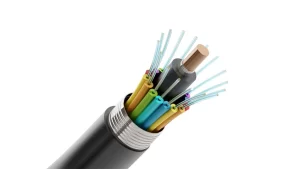
What Is a Fiber Optic Cable
 What Is a Fiber Optic Cable Made Of?
What Is a Fiber Optic Cable Made Of?
A fiber optic cable consists of several key components that work together to transmit data using light. The main components of a fiber optic cable include:
- Core: The core is the central part of the cable through which the light travels. It is made of glass or plastic and is the thinnest part of the cable.
- Cladding: Surrounding the core, the cladding is a layer of material (usually glass or plastic) that reflects light back into the core, ensuring that the light signals stay contained and don’t escape.
- Buffer Coating: The buffer coating provides protection to the fiber and helps prevent physical damage to the core and cladding.
- Outer Jacket: The outer protective layer of the fiber optic cable, which is made from plastic or other durable materials to provide physical protection from environmental factors like moisture, abrasion, and physical stress.
 Types of Fiber Optic Cables
Types of Fiber Optic Cables
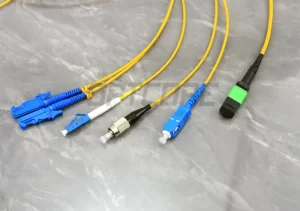
Types of Fiber Optic Cables
There are two primary types of fiber optic cables used in communication systems: single-mode fiber (SMF) and multi-mode fiber (MMF).
1. Single-Mode Fiber (SMF)
- Description: Single-mode fiber is designed to carry light directly down the fiber, without much reflection. It has a smaller core size, typically around 8 to 10 microns.
- Use: SMF is ideal for long-distance data transmission and high-bandwidth applications, such as telecommunications, internet infrastructure, and global networks.
- Advantages: It supports higher bandwidth and can transmit data over greater distances without much signal loss, making it the best choice for long-range data connections.
2. Multi-Mode Fiber (MMF)
- Description: Multi-mode fiber has a larger core size (typically around 50 to 100 microns) and allows light to travel along different paths, or modes, within the core.
- Use: MMF is commonly used for shorter distance connections, such as in local area networks (LANs), data centers, and internal office networks.
- Advantages: MMF is typically cheaper than SMF and easier to install, but its signal can degrade over longer distances due to the multiple paths of light.
 How Does Fiber Optic Cable Work?
How Does Fiber Optic Cable Work?
Fiber optic cables work by transmitting light through the core of the fiber. The light signals are typically generated by lasers or LEDs at the transmitting end and received at the receiving end by photodetectors. The cladding around the core ensures that the light stays within the core by reflecting it back into the fiber. This process is known as total internal reflection, which enables the signal to travel over long distances without significant signal loss.
Fiber optic cables are capable of transmitting high-frequency signals over long distances, with much less interference compared to traditional copper cables. This makes them an excellent choice for high-speed internet connections, data transmission, and video streaming.
 Advantages of Fiber Optic Cables
Advantages of Fiber Optic Cables
Fiber optic cables offer several advantages over traditional copper cables. Some of the key benefits include:
1. Higher Bandwidth and Speed
Fiber optic cables can transmit data at much higher speeds and with greater bandwidth compared to copper cables. This is why fiber optics are used in high-speed internet and telecommunications.
2. Longer Distance Transmission
Unlike copper cables, fiber optic cables can transmit signals over much longer distances without significant signal degradation. Single-mode fiber, for example, can carry data over several kilometers without needing signal boosters.
3. Immunity to Electromagnetic Interference (EMI)
Fiber optic cables are not susceptible to electromagnetic interference (EMI) because they use light instead of electrical signals. This makes them ideal for data transmission in environments with high interference, such as industrial areas or near power lines.
4. Lightweight and Flexible
Fiber optic cables are much lighter and more flexible than copper cables, making them easier to install and maintain, especially in tight spaces or areas with complex cabling setups.
5. Enhanced Security
Since fiber optic cables do not emit signals like copper cables, they are more secure. They are harder to tap into without being detected, making them ideal for secure communication in government, financial, and military applications.
 Applications of Fiber Optic Cables
Applications of Fiber Optic Cables
Fiber optic cables are widely used in various industries due to their high speed, long-distance capability, and resistance to interference. Some common applications include:
- Internet and Broadband Connections: Fiber optic cables are the backbone of high-speed internet connections, providing fast and reliable data transmission for homes, businesses, and data centers.
- Telecommunications: Fiber optic cables are used by telecom companies to transmit voice, video, and data signals over long distances.
- Cable TV: Fiber optic technology is used to deliver high-definition cable television signals with superior picture and sound quality.
- Medical Equipment: Fiber optics are used in medical devices such as endoscopes, where light is used to illuminate internal areas of the body.
- Military and Aerospace: Fiber optic cables are used for secure communications in the military, as well as in aircraft and spacecraft for transmitting data and video signals.
 How to Choose the Right Fiber Optic Cable?
How to Choose the Right Fiber Optic Cable?
Choosing the right fiber optic cable depends on several factors, including the distance, speed requirements, and environment:
- Single-Mode vs. Multi-Mode: Choose single-mode fiber (SMF) for long-distance and high-bandwidth connections, and multi-mode fiber (MMF) for short-distance applications like local area networks (LANs).
- Distance and Performance: Consider the distance the signal needs to travel. Single-mode fiber is ideal for longer distances, while multi-mode fiber is better suited for shorter distances.
- Environmental Factors: Ensure that the cable is suitable for the environment. For outdoor installations, choose outdoor-rated fiber optic cables with rugged jackets that can withstand harsh weather conditions.
 Fiber Optic Cables from TOT Wire & Cable
Fiber Optic Cables from TOT Wire & Cable
At TOT Wire & Cable, we specialize in providing high-quality fiber optic cables for all your data transmission needs. Our cables offer superior performance, speed, and security, ensuring reliable communication for residential, business, and industrial applications.
Features of Our Fiber Optic Cables:
- Available in single-mode and multi-mode options
- Durable and weather-resistant jackets for outdoor use
- High-speed data transmission with minimal signal loss
- Custom lengths and bulk orders available

 FAQ: Common Questions About Fiber Optic Cables
FAQ: Common Questions About Fiber Optic Cables
Q: What’s the difference between single-mode and multi-mode fiber?
A: Single-mode fiber is ideal for long-distance and high-speed connections, while multi-mode fiber is better for shorter distances and is generally used in local area networks.
Q: Can I use fiber optic cables for home internet?
A: Yes! Many fiber optic internet providers offer high-speed fiber connections to homes for faster internet speeds.
Q: How fragile are fiber optic cables?
A: Fiber optic cables are more fragile than copper cables and should be handled with care during installation to avoid breaking the fibers inside. However, they are durable and resistant to interference.
 Conclusion
Conclusion
Fiber optic cables are the future of high-speed communication, offering faster speeds, longer distances, and immunity to interference. Whether you’re setting up an internet connection, installing a telecommunications network, or using fiber for secure communications, fiber optic cables provide the best solution for reliable, high-performance data transmission.
TOT Wire & Cable offers a wide range of fiber optic cables designed for various applications. Get in touch with us today for more information, product specs, or bulk orders.

 What Is a Fiber Optic Cable?
What Is a Fiber Optic Cable? What Is a Fiber Optic Cable Made Of?
What Is a Fiber Optic Cable Made Of? Types of Fiber Optic Cables
Types of Fiber Optic Cables How Does Fiber Optic Cable Work?
How Does Fiber Optic Cable Work? Applications of Fiber Optic Cables
Applications of Fiber Optic Cables How to Choose the Right Fiber Optic Cable?
How to Choose the Right Fiber Optic Cable? Fiber Optic Cables from TOT Wire & Cable
Fiber Optic Cables from TOT Wire & Cable FAQ: Common Questions About Fiber Optic Cables
FAQ: Common Questions About Fiber Optic Cables Conclusion
Conclusion